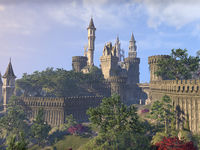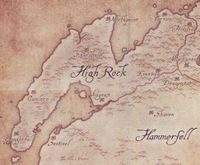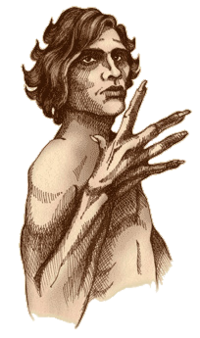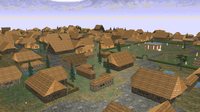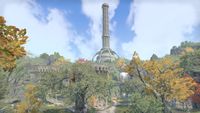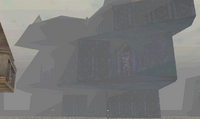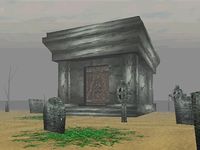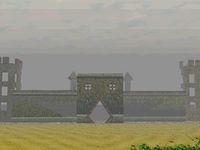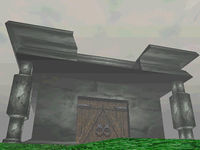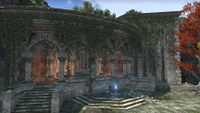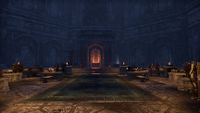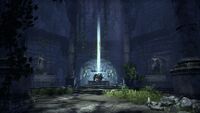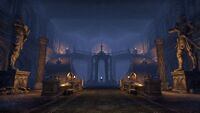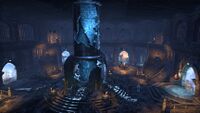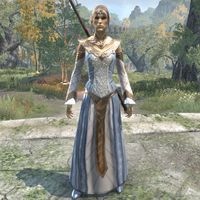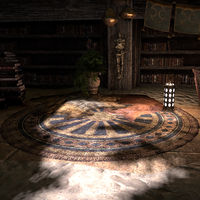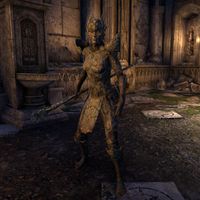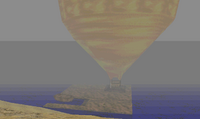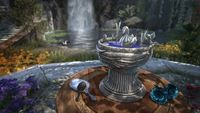Lore:Direnni
- "Few families in Tamriel can boast so many famous figures, wielding so much power over the fate of so many. Our warriors and kings are stuff of legend, and it is not to dismiss their honor and their achievements to say you have heard quite enough about them." — Vorian Direnni, De Rerum Dirennis
The Direnni (also known as Clan Direnni[1] and House Direnni)[2] are an aristocratic merchant clan of Altmer[nb 1] (formerly Aldmer)[3][4] whose members laid the foundation for modern alchemy, conjuration, and enchanting.[1][5][6] The Direnni are most credited as being the Elven ancestors of the Bretons,[4] a race produced by their intermingling with the Nedic Druids of Galen for centuries during the Merethic Era.[4][7] The Direnni established themselves a powerful sovereignty referred to as the Direnni Hegemony,[8] which lasted from 1E 355 to 1E 498.[9][UOL 1] However, some consider their rule in the years leading up to its establishment as part of the Direnni Hegemony as well.[2][10][11][12] At its peak, this hegemony stretched from all of High Rock[9][6] into large parts of Skyrim and Hammerfell.[9][13][6][UOL 1]
The Direnni are the keepers of the Isle of Balfiera,[14] which is used as a neutral meeting place for diplomatic negotiations by the kingdoms of High Rock.[15] The isle is also home to the Adamantine Tower (or Direnni Tower), a structure that helps keeps the Mundus stable.[16] The tower was used as a fortress, prison, and palace during the Direnni Hegemony.[15] At maturity, every Direnni of high blood is brought into the Adamantine Tower, conducted to the Foundation Vault, and shown the Zero Stone. During the ceremony, they are allowed to touch it once so they can feel the transcendent mystical power that courses through it.[6]
The Direnni are known more for their legendary warriors and monarchs, and less for their spellcasters, but magic is still an important tradition to them.[17] The Direnni are described as egotistical even for Altmer,[UOL 2] but they view their cousins from the Summerset Isle as a "prickly bunch".[18] The Direnni worship the Aedra,[19][20] but the clan obtained a bulk of their power from trafficking with Daedra.[21] In the First Era, attempting to deal with Daedric Princes led to a catastrophe; the creation of a portal to Oblivion that cannot be fully sealed.[22] Aside from Daedra,[22] the Direnni were known to utilize golems,[18] and quasigriffs.[23] They considered Phynaster as their patron deity and "teacher".[19] The Direnni's emblem was an alchemy alembic in the Second Era,[24] and horned bulls in the Third Era.[25]
In their prime, Clan Direnni posed a looming threat to the First Empire of the Nords, and the Alessian Empire.[8] The Direnni also wielded fearsome magics, imbuing their financial records with "dangerous theosophist numeral-symbolism" which requires magical precautions for them to be read without harm.[5] Cryptic documents describing a ritual dubbed the "Grand and Thaumaturgical and Most Puissant Trebuchet of Overarching Peril" were discovered on Caecilly Island, describing unleashing spirits for the subjugation of all foes of the Direnni.[26] The Direnni took interest in the Flask of Lillandril, but it was ultimately lost before it reached them.[27] The Breton-made artifact Chrysamere was influenced by the magic of the Breton's elven forebears, and it saw use in securing High Rock for the Direnni.[28]
History[edit]
Merethic Era[edit]
The Direnni's origins are shrouded in mystery. Clan Direnni came from the small farming village of Tyrigel which sat on the banks of the river Caomus (then called the Diren River hence the family's name) on Summerset Isle. Using his knowledge of alchemy, Asliel Direnni poisoned a barbarian tribe called the Locvar that were continuously raiding Tyrigel. With this external threat dealt with, the way was paved for the future prosperity of the Direnni farms, and generations later they would leave Summerset and travel to mainland Tamriel which would further increase their power and influence.[17]
According to Beredalmo the Signifier, Direnni Cygnus, "the Swan of Tyrigel", was the progenitor to Clan Direnni as she discovered the Isle of Balfiera and decreed that her descendants should carry her name,[6] challenging the clan's River Diren name origin.[17] While there, the mortal mages of the Direnni Clan deduced the "reality-affirming properties" of the island's tower.[29][UOL 2] Merethic Era Elves later imitated the Adamantine Tower with other creations, such as the Crystal Tower and White-Gold Tower.[29] The Direnni's discovery contradicts the common claim that Topal the Pilot was the earliest Aldmeri explorer of Tamriel, as he was a figure that took orders from the Crystal Tower.[30]
The elven ancestry of Bretondom originates from the Aldmer that settled High Rock sparsely and in very specific locations, the most successful being Clan Direnni,[8] who came to the province from the Summerset Isle in the Middle Merethic Era, and rediscovered and captured the Adamantine Tower.[3][6] Some believe the Direnni were following their destiny to rule from Balfiera, while others believed that the clan was exiled.[14] If Man or Mer came to High Rock first is debated in scholarly circles. Some believe that the Druids of Galen and their Druid King were already established in the province when the Aldmer arrived,[4] while others claim that these Nedes arrived in High Rock afterwards, and encountered the elves gradually with a variety of reactions and outcomes.[31] It is speculated that there was internal strife between the various Aldmer clans of High Rock.[UOL 3] There's also evidence that a beastfolk population were the province's original inhabitants, though they did not build permanent communities, and what interactions they had with Men and Mer are unknown.[8]
The Direnni didn't enslave the Nedes as the Ayleids of Cyrodiil did; instead, they ruled them as a noble caste. The elves established a system of feudal vassalage over their new subjects and took Nedic concubines.[1][6] The Direnni enjoyed many privileges over their human subjects including the 'Perquisite of Coition', the right to engage in recreational intercourse with any Nede of their choice.[1] They inevitably interbred with their human subjects, producing Half-Elven children (also known as Manmer).[1][15] Despite mingling with Nedes, typically only "pureblooded" Direnni rose to power.[32]
The Druids of Galen led this new race when it first emerged,[UOL 4] for the children begat from these unions weren't accepted by their Direnni parents, as they were considered sub-Mer. Instead, they were given privileged positions among the Nedes, which eventually lead to a recognizable mixed-blood human caste dubbed "Bretons", from the Ehlnofex "beratu", meaning "half".[4][1] These Bretons were only allowed to marry humans, and over time, the Breton's elven blood thinned, and their human features became more prominent.[1] While the Aldmer maintained control of Tamriel, Clan Direnni coexisted peacefully and flourished alongside their Nedic and Half-Elven subjects.[31] It would not last forever, however, as localized groups of Bretons displeased with Mer made trouble for their Elven overlords long before they officially came to blows.[7] Some Manmeri devotional idols from this period depict Mara as an elven woman in a lover's embrace with a man, suggesting Aldmeri culture may have been welcomed with relatively open arms.[33]
First Era[edit]
Written in 1E 200, the Tamrilean Tractates speak of an early encounter between a Nord hunting party and the Bretons. The Bretons were scarcely recognizable as Men, and the Nords attacked them thinking they were another strain of Aldmeri. The Nords ceased their assault when one of the Bretons spoke in broken Nordic, and the hunting party brought word of this "newly discovered" race of Men back to Windhelm. The Nords believed the Manmeri from beyond the Reach were descended from human slaves taken during the Night of Tears. King Vrage made it the First Empire of the Nords' main priority to liberate the Bretons from their elven masters.[15] Vrage's campaign brought him as far as the Bjoulsae, but Clan Direnni's mages impeded their progress, and the elves were aided in battle by many of their Breton vassals.[15]
At some point in the distant past, sisterhoods repulsed by the Direnni became the Wyrd when they retreated into isolation, and embraced the more primal aspects of nature.[34] Ancient druids were considered "Meriphilic",[2] but eventually their tolerance for outside influence would wane and they would find themselves fighting for the soul of High Rock.[11] The Direnni seeking to tame nature, forged a pact with the Earthbones to protect their settlements from the encroachment of the wilds.[35] The Druids of Galen believed civilization should live alongside nature and not tame it,[11] and they attempted to hold onto their power with fearsome magic, either behind the scenes or directly.[36] Ultimately, they split from Bretondom around 1E 330, when two major powers vowed for control of High Rock. The Direnni Hegemony did not take kindly to the attempts for druidic governance of the province, and the Alessian Order persecuted them as they deviated from their religion.[34] Following the guidance of a song or an Elder Scroll, the druids split from their mainland brethren and journeyed into the Systres,[2] and a few opted to remain on the mainland.[11][34]
The Direnni Hegemony[edit]
After much infighting between the Mer of High Rock over who would rule over the province,[37] circa 1E 355, Clan Direnni emerged victorious through political maneuvering and devious machinations,[9] and by 1E 358, the Direnni Hegemony had a presence in the Western Reach. The joint army of Cyrodiilic Emperor Ami-El and Skyrim attacked Clan Direnni in an attempt to halt their advances.[UOL 5] The area was later claimed by the First Empire of the Nords. Following the collapse of this Nordic Empire in 1E 420, the Western Reach was retaken by the Direnni,[6] who slaughtered the majority of Nord colonists; as a result, the Nordic ancestry of the Reachmen is comparatively weak.[15][38] Eventually, the Aldmeri overseers were eliminated, but traces of their blood forever remained in the veins of the native Reachmen.[39][15]
With the rise of the Alessian Order in Cyrodiil in 1E 361, many Ayleids fleeing Cyrodiil migrated to High Rock to escape the order in an exodus known as the Ayleid Diaspora, which may have strengthened Clan Direnni as these immigrants were absorbed into their hegemony.[40] As of then the Direnni were led by King Ralethiel.[41] When Laloriaran Dynar and his people arrived at the Bjoulsae in 1E 375, they were welcomed by the Direnni and given a place to settle.[13][42]
Though they were already long established there,[42] the Direnni's claim over the Isle of Balfiera was strengthened when it was purchased by Ryain Direnni in 1E 461,[43][13][44] and was used as a base for their war against Skyrim.[13] Clan Direnni emerged victorious and managed to conquer High Rock, some parts of Skyrim and Hammerfell by 1E 477[9][13], going as far east as Markarth and Elinhir.[6] Ryain and his Breton Legions were the first to sack the Orc hold of Orsinium.[6] The Kings of the Colovian West joined with Kvatch and Skingrad to resist the Alessian Empire. Soon after, Skyrim under High King Hoag Merkiller and Ryain Direnni of High Rock joined the resistance. Ryain Direnni outlawed the Alessian Reform and put its major advocates to death. Direnni forces began to harass the Colovian West, pushing for the Heartland. Following the Direnni involvement in Cyrodiil, the Alessians began conquering territories of the Direnni Hegemony. By 1E 479 Craglorn had fallen to the Imperials.[13]
As the Direnni Hegemony expanded geographically, the elves, who were few in number, passed increasing powers of administration to the Breton caste.[1] Clan Direnni was inspired to outlaw the religion of the Alessian Reform by Rislav's victory against Emperor Gorieus, and began pushing into Imperial territory.[43] The timeframe between 1E 480 and 1E 482 would see a coming conflict with the Alessian Order. Seeing the threat the Order posed, Aiden Direnni signed the Rights Charter out of necessity, in efforts to muster troops for the coming conflict.[13] Daggerfall became a minor base of operations for the Direnni and their allies.[45] Aiden's army defeated the Alessians on the 8th of Sun's Dawn at the Battle of Glenumbria Moors in 1E 482 with the assistance of Breton knights,[46][47] the last Ayleid king,[40] and Hoag Merkiller.[48][49]
The master summoners of the Direnni were the first to discover that a conjurer could impose any desired shape on a Flame Atronach, such as that of a horse, which they used in the Battle of Glenumbria Moors.[50] Peregrine Direnni was also the first to conjure the first ever Flame Atronach in the form of a camel.[51]
End of the Direnni Hegemony[edit]
Thoroughly spent, the Direnni eventually retreated to Balfiera,[1] and their hegemony fell circa 1E 498.[9][UOL 1] With most of High Rock free from Elven control by 1E 500,[15] the Breton kingdoms began establishing themselves around this time,[52] though the elves would be accepted and allowed to remain in the province for most of the Second Era.[53] The Bretons' rise to prominence in High Rock initially started through villages being founded in tactical locations, such as Wayrest, which started as a fishing hamlet. Nordic cities such as Camlorn became Breton due to assimilation from the growing Breton population as opposed to conquest. Over time, the emerging Bretons absorbed the remaining Nordic population in High Rock, and the land would be definitively Breton by the end of the First Era.[8]
Though the province was in Breton hands, it was by no means a cohesive nation. Clan Direnni's retreat to Balfiera left a vacancy in the way of a united government, and High Rock was left with a hundred fiefdoms to squabble over power.[8] The elf-blooded nobility of Greater Bretony took up the mantle Clan Direnni left behind, maintaining the feudal hierarchy their elven predecessors forged and placing their noble families, the oldest of whom the strongest elven blood flowed strongly within, in the position of aristocracy. The new noble class, consisting of highborn Bretons, justified their ascension to aristocracy and the preservation of the peasant class by disassociating themselves from their elven heritage. The Bretons vilified the Direnni, and redefined themselves around the notion that they were not elves. The Breton nobility fabricated a history of noble resistance to Direnni rule to suit the narrative that Breton cultural identity had no elven roots. In time, a merchant class sprouted and thrived, trading around Tamriel's coasts.[1] The Bretons were also left to deal with the encroachment of the Wilds, for the Direnni had renounced their covenant with the Earthbones after their retreat, something thought done out of spite.[35]
During the late-fifth century, violence against the Direnni began under King Festrien Spenard I of the House Spenard. Supported by vassals from House Aurmine, the despot king's Knights of the Pale Order slaughtered the Direnni wholesale during the latter years of their flight from High Rock. Knights of the Pale Order kept lists of Direnni warriors and magisters they slew.[54] In spite of the vilification of the Direnni and disassociation from their elven heritage, at least some Bretons would continue to emphasize their elven blood.[19] By the time the Redguards arrived in Tamriel a few centuries later, Clan Direnni had already retreated to Balfiera Island in the Iliac Bay.[55]
The Second Empire was established in 1E 2703 after Reman Cyrodiil suppressed the Akaviri invasion of Tamriel at the battle of Pale Pass.[56] With the Akaviri's number and their tactics boosting his ranks, Reman continued on to pacify the rest of Tamriel.[57][56] High Rock was already weakened by the Akaviri invasion, with the population of the Iliac Bay being halved.[45] This resulted in an alliance known as the League of Unrest being created between Daggerfall, Wayrest, and Balfiera, in an effort to stop Reman's forces.[58] They were defeated however, and Reman formed modern-day Cyrodiil using the Colovian Estates, Nibenay, and parts of High Rock.[56]
While most Direnni relocated to the Isle of Balfiera in High Rock, some members of the clan stayed on Summerset, retaining the clan's holdings around the Diren Valley. Sometime in the First Era, one of the remaining Direnni—by the name of Lauriel—became highly skilled in the arts of necromancy, to the horror of her family. Facing the possibility of execution, Lauriel refused to repent and claimed that she could not be killed and would only rise again. To prevent Lauriel from doing this, the Direnni buried her alive in a sarcophagus deep below the Direnni Acropolis, and bound her spirit to it by kindling two sacred flames in braziers. A Keeper was then appointed to make sure the braziers remained lit, and the title was passed down between generations. However, the Direnni population on Summerset diminished with time, and they lost contact with their kin on Balfiera.
Second Era[edit]
By the mid-Second Era, the last Keeper was long dead, and the braziers had gone out. In time, Lauriel managed to manifest as a ghost, and haunted the Acropolis, hoping to contact and convince someone to release her from her imprisonment. Around 2E 582, the Vestige entered the crypts of the Direnni Acropolis. Lauriel tried to convince them to release her by burning her remains, while the lingering spirits of the dead Keepers wished to see the braziers relit. It is unknown what decision was made by the Vestige.[59]
During the Three Banners War, both the Daggerfall Covenant and Aldmeri Dominion used the history of the Direnni against each other in propaganda leaflets, with the Daggerfall Covenant pointing out that they let Clan Direnni live in their borders as proof that they could live with elves in peace,[60] whereas the Aldmeri Dominion used the history of Clan Direnni to generate sympathy for the Altmer describing their Direnni cousins as "cruelly suppressed".[61] During that time period, Direnni considered themselves to be more humble, pragmatic and open-minded than Altmer of the Summerset Isles. Clan Direnni's intelligence guild, the Sinderill, had active agents across Tamriel.[18] The first of Queen Ayrenn's adventures saw her going to the Isle of Balfiera to be trained with the Direnni in the art of war. She became a seasoned blade-dancer and she partook in studies of the arcane arts.[62]
Third Era[edit]
The Isle of Balfiera was an independent territory before the events of the Warp in the West, after which it fell under the dominion of one of the four surviving kingdoms of the Iliac Bay region (Daggerfall, Orsinium, Sentinel, or Wayrest).[63]
Fourth Era[edit]
Thalmor agents were harassing and possibly murdering refugees in Balfiera around 4E 48; the victims were all of mixed blood or had associations considered by the Aldmeri Dominion to be "unclean".[64]
Notable Figures[edit]
- Direnni Cygnus, the Swan of Tyrigel, discovered Balfiera and its Tower and claimed it for her own, decreeing that all of her clan who came after would bear her name.[6]
- Asliel Direnni is believed to have been the first individual to formulate alchemy into an art and science. As such, some Direnni banners feature an alembic in recognition of his accomplishment. He also became a member of the Psijic Order.[17][6]
- Raven Direnni, with her better known cousins Aiden and Ryain, brought an end to the tyranny of the latter Alessian Empire. Before the Psijics of Artaeum, it is said, she created the art of enchantment, learning how to bind a soul into a gem and use that to enchant all manners of weaponry.[17][6] One known creation of hers is an inflammable rug, which was supposedly one of her first creations after she discovered the principles of enchantment.
- Ryain Direnni, who bought the Isle of Balfiera and made it his seat of power. He then started conquering High Rock,[43] making the Direnni Hegemony stretch as far east as Markarth and Elinhir.[6]
- Prince Aiden Direnni, who led Direnni forces to victory against the Alessians in the Battle of Glenumbra Moors in 1E 482.[6]
- Beredalmo the Signifier, a famous historian and author.[6]
- King Ralethiel Direnni, who led Direnni during the times of the rise of the Alessian Order.[41]
- Corvus Direnni was the Arch-Conjurer of clan Direnni at some unknown point and mentored students for the Master Conjurer test.[50][51][6] He was also a participant of the Battle of Glenumbra Moors.[13]
- Peregrine Direnni drove an entire Ra Gada flotilla back to Sentinel by merging her very will with the waves of the Iliac Bay.[6]
- Pelladil Direnni, who was Imperial Battlemage to the first ruling Potentate, Versidue-Shaie, and encouraged the Guild Act which allowed for the creation of the Mages Guild and Fighters Guild. Pelladil was also responsible for the construction of Blackrose Prison.[6] He was the great great grandfather to Jovron Direnni.
- Jovron Direnni, an Imperial Battlemage to the court of the Dunmer Empress of Tamriel, Katariah, assisting her in creating peace in a time of turmoil. He was also the grandfather to Medora Direnni.[17]
- Medora Direnni, who had a curse placed on her by the insane Nulfaga and was helped by The Agent.
- Chimere Graegyn was a human retainer of the Direnni, and a master of conjuration. He was cast into Oblivion and forbidden to die after scheming against Mehrunes Dagon circa 3E 172, trapped in the Chimera of Desolation for all eternity.[21]
- Lady Thorn, also known as Lady Ingerien, was an Altmer Vampire Lord who ruled over Castle Thorn in the Second Era.[65]
- Maalanrie Direnni, who "walked through dreams" and summoned the first Iron Atronach Senche to free her from captivity.[66]
- Irastimil Direnni was a notable Direnni scholar who created quasigriffs through magic and selective breeding.[23]
- Utheilla Direnni was, according to dubious sources,[UOL 6] an Empress of Cyrodiil, a wife of Emperor Magnus Septim, and mother of the infamously mad Emperor Pelagius Septim III.[67]
- Vorian Direnni was a long-lived sorcerer and author of De Rerum Dirennis.[17]
- Calani Direnni was a pioneer of conjuration,[22] and participant of the Battle of Glenumbra Moors.[13]
Gallery[edit]
Heraldry[edit]
Architecture[edit]
Misc[edit]
Books[edit]
- Once by Beredalmo the Signifier — A bitter-sweet ode celebrating the achievements and failures of the Direnni clan
- Trebuchet Ritual by Forromeo — The ritual of Clan Direnni's mighty trebuchet
- De Rerum Dirennis by Vorian Direnni — Tales about a creator of Alchemy Science
- Tower of Adamant by Hrerm House-builder, Bards College, Solitude — A Nord architect's notes on the construction of the Adamantine Tower
- The Origins of Conjuration — On the wonders and dangers of conjuration
- The Battle of Glenumbria Moors — Song on the famous 1E 482 battle between the Alessian Empire and the Direnni
Notes[edit]
- Daggerfall writer Ted Peterson likened the First Era-version of the Direnni to the Medici family. He describes them as a noble family with a lot of influence in the past, doing many good deeds by sponsoring the arts and other things, but at the same time being very shady and in the modern day, claiming to have done things they weren't responsible for.[UOL 3]
- The name of the Direnni family originated from a roleplaying campaign done by Julian LeFay.[UOL 7]
- Dumonte family was known for having a considerable familial connection with the Clan Direnni.[68]
See Also[edit]
- For game-specific information, see the Elder Scrolls Online article.
References[edit]
- ^ a b c d e f g h i j The Bretons: Mongrels or Paragons? — Phrastus of Elinhir
- ^ a b c d Systres History: Volume 1 — Trilam Heladren, Associate Dean of Eltheric History, University of Gwylim
- ^ a b Before the Ages of Man — Aicantar of Shimerene
- ^ a b c d e Modern Day Bretons: Man or Mer? — Vastyr Historian Filibert Beauchamp
- ^ a b Pocket Guide to the Empire, 1st Edition: Aldmeri Dominion — Imperial Geographical Society, 2E 864
- ^ a b c d e f g h i j k l m n o p q r s Once — Beredalmo the Signifier
- ^ a b Loremaster's Archive - Tamriel's Dungeons — Dhulef
- ^ a b c d e f Pocket Guide to the Empire, 3rd Edition: The Sons and Daughter of the Direnni West: High Rock — Imperial Geographical Society, 3E 432
- ^ a b c d e f The Daggerfall Chronicles — Ronald Wartow
- ^ Exodus of the Druids — Druid Laurel of the Stonelore Circle
- ^ a b c d Druid Ryvana's dialogue in ESO: High Isle
- ^ Druid Audrine's dialogue in ESO: High Isle
- ^ a b c d e f g h i A Life of Strife and Struggle — King Laloriaran Dynar
- ^ a b Bailiff Erator's dialogue in ESO: Summerset
- ^ a b c d e f g h Pocket Guide to the Empire, 1st Edition: High Rock — Imperial Geographical Society, 2E 864
- ^ Lord of Souls — Greg Keyes
- ^ a b c d e f g De Rerum Dirennis — Vorian Direnni
- ^ a b c Norianwe's dialogue in ESO
- ^ a b c Varieties of Faith... — Brother Mikhael Karkuxor of the Imperial College
- ^ Crafting Motif 89: Ancestral High Elf Style — Raven Direnni
- ^ a b Harvest's End, 3E 172 — Chimere Graegyn
- ^ a b c The Origins of Conjuration
- ^ a b Quasigriff mount description in ESO
- ^ Direnni Banner, Hanging furnishing in ESO
- ^ Banners during Medora's Freedom quest in Daggerfall
- ^ Trebuchet Ritual — Forromeo
- ^ Elven Artifacts vIII — Ith-Mok
- ^ Loremaster's Archive - Infinite Archive — Master Malkhest
- ^ a b Subtropical Cyrodiil: A Speculation — Lady Cinnabar of Taneth
- ^ Father Of The Niben — Florin Jaliil
- ^ a b Frontier, Conquest — University of Gwylim Press, 3E 344
- ^ Direnni Palatial Art Antiquity Codex entries in ESO: Greymoor
- ^ Manmer Coupled Idol Antiquity Codex entries in ESO: Greymoor
- ^ a b c Wyrd and Druid — Archdruid Barnabe's Discourse with Mainlanders, 2E 553
- ^ a b The Viridian Sentinel
- ^ High King Emeric's dialogue in ESO
- ^ Druid King Kasorayn's dialogue in ESO: Firesong
- ^ Crafting Motif 46: Frostcaster Style — Doctor Alfidia Lupus, Imperial Ethnographer
- ^ The Improved Emperor's Guide to Tamriel: Northern Bangkorai and the Mountains — Flaccus Terentius, 2E 581
- ^ a b The Last King of the Ayleids — Herminia Cinna
- ^ a b Ayleid Ghost's dialogue in ESO
- ^ a b Ayleid Survivals in Valenwood — Cuinur of Cloudrest, 4th Tier Scholar of Tamrielic Minutiae
- ^ a b c Rislav The Righteous — Sinjin
- ^ Tower of Adamant — Hrerm House-builder, Bards College, Solitude
- ^ a b A History of Daggerfall — Odiva Gallwood
- ^ Alana Relin's dialogue during A Step Back in Time in ESO
- ^ Commander Parmion's dialogue during A Step Back in Time in ESO
- ^ The Final Lesson — Aegrothius Goth
- ^ Five Songs of King Wulfharth
- ^ a b Flame Atronach Horse mount description in ESO
- ^ a b Flame Atronach Camel mount description in ESO
- ^ The Horse-Folk of Silverhoof — Doctor Nabeth al-Gilane, Khefrem Academy of Yokudan Heritage
- ^ A Warning to the Aldmeri Dominion — Erystera Ligen
- ^ Ring of the Pale Order Antiquity Codex entries in ESO: Greymoor
- ^ Elder Scrolls Online website - Lore Answers
- ^ a b c Pocket Guide to the Empire, 1st Edition: Cyrodiil — Imperial Geographical Society, 2E 864
- ^ Legacy of the Dragonguard — Kiasa-Veda, the Chronicler of Blades
- ^ Maiko K'Elmar's dialogue in Redguard
- ^ Events of ESO: Summerset
- ^ A Warning to the Aldmeri Dominion — Erystera Ligen
- ^ Crimes of the Daggerfall Covenant — Aicantar of Shimmerene, Sapiarch of Indoctrination
- ^ The Rise of Queen Ayrenn — Nuulehtel of Skywatch
- ^ The Warp in the West — Ulvius Tero
- ^ The Infernal City — Greg Keyes
- ^ Letter of Welcome — Lady Ingerien of Clan Direnni
- ^ Iron Atronach Senche mount description in ESO
- ^ The Madness of Pelagius — Tsathenes
- ^ Augustine Viliane Answers Your Questions — Sibyl Augustine Viliane
Note: The following references are considered to be unofficial sources. They are included to round off this article and may not be authoritative or conclusive.
- ^ a b c Xanathar's Library Archive/History
- ^ a b Lawrence Schick and Phrastus on Altmer Culture
- ^ a b Ted Peterson on High Rock and Summerset - Legendary Edition
- ^ Twitch Stream of ESO Live at Home Firesong DLC & Update 36 Preview, 17:09
- ^ Matt Grandstaff's Posts
- ^ Time and Place inconsistencies - Ted Peterson
- ^ Ted Peterson's Posts
|
||||||||||||||
|
||||||||||||||||||||||||||||||||||||||||||||||||||||||||


